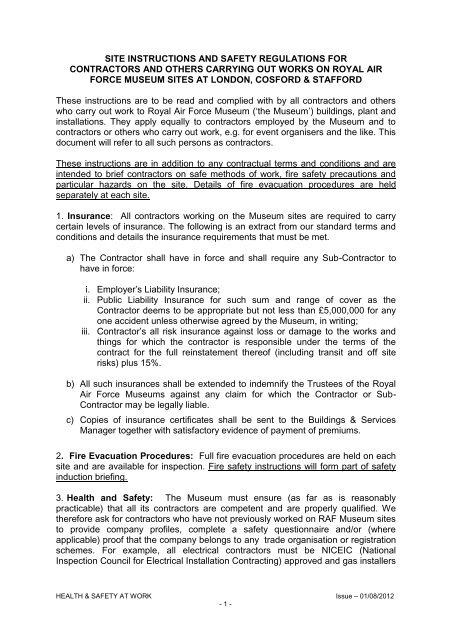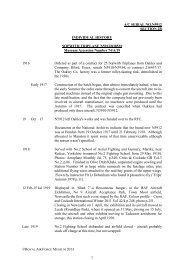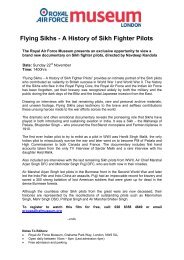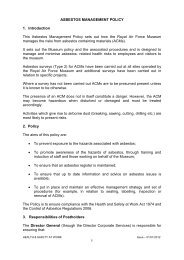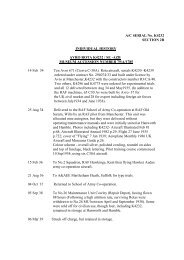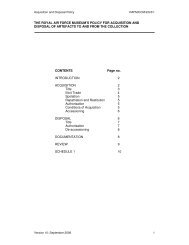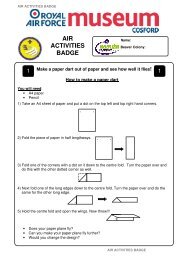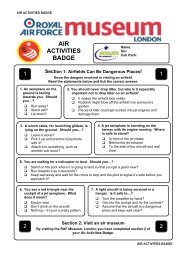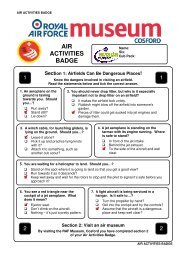Site Instructions and Safety Regulations for Contractors Aug 2012
Site Instructions and Safety Regulations for Contractors Aug 2012
Site Instructions and Safety Regulations for Contractors Aug 2012
Create successful ePaper yourself
Turn your PDF publications into a flip-book with our unique Google optimized e-Paper software.
SITE INSTRUCTIONS AND SAFETY REGULATIONS FOR<br />
CONTRACTORS AND OTHERS CARRYING OUT WORKS ON ROYAL AIR<br />
FORCE MUSEUM SITES AT LONDON, COSFORD & STAFFORD<br />
These instructions are to be read <strong>and</strong> complied with by all contractors <strong>and</strong> others<br />
who carry out work to Royal Air Force Museum (‘the Museum’) buildings, plant <strong>and</strong><br />
installations. They apply equally to contractors employed by the Museum <strong>and</strong> to<br />
contractors or others who carry out work, e.g. <strong>for</strong> event organisers <strong>and</strong> the like. This<br />
document will refer to all such persons as contractors.<br />
These instructions are in addition to any contractual terms <strong>and</strong> conditions <strong>and</strong> are<br />
intended to brief contractors on safe methods of work, fire safety precautions <strong>and</strong><br />
particular hazards on the site. Details of fire evacuation procedures are held<br />
separately at each site.<br />
1. Insurance: All contractors working on the Museum sites are required to carry<br />
certain levels of insurance. The following is an extract from our st<strong>and</strong>ard terms <strong>and</strong><br />
conditions <strong>and</strong> details the insurance requirements that must be met.<br />
a) The Contractor shall have in <strong>for</strong>ce <strong>and</strong> shall require any Sub-Contractor to<br />
have in <strong>for</strong>ce:<br />
i. Employer’s Liability Insurance;<br />
ii. Public Liability Insurance <strong>for</strong> such sum <strong>and</strong> range of cover as the<br />
Contractor deems to be appropriate but not less than £5,000,000 <strong>for</strong> any<br />
one accident unless otherwise agreed by the Museum, in writing;<br />
iii. Contractor’s all risk insurance against loss or damage to the works <strong>and</strong><br />
things <strong>for</strong> which the contractor is responsible under the terms of the<br />
contract <strong>for</strong> the full reinstatement thereof (including transit <strong>and</strong> off site<br />
risks) plus 15%.<br />
b) All such insurances shall be extended to indemnify the Trustees of the Royal<br />
Air Force Museums against any claim <strong>for</strong> which the Contractor or Sub-<br />
Contractor may be legally liable.<br />
c) Copies of insurance certificates shall be sent to the Buildings & Services<br />
Manager together with satisfactory evidence of payment of premiums.<br />
2. Fire Evacuation Procedures: Full fire evacuation procedures are held on each<br />
site <strong>and</strong> are available <strong>for</strong> inspection. Fire safety instructions will <strong>for</strong>m part of safety<br />
induction briefing.<br />
3. Health <strong>and</strong> <strong>Safety</strong>: The Museum must ensure (as far as is reasonably<br />
practicable) that all its contractors are competent <strong>and</strong> are properly qualified. We<br />
there<strong>for</strong>e ask <strong>for</strong> contractors who have not previously worked on RAF Museum sites<br />
to provide company profiles, complete a safety questionnaire <strong>and</strong>/or (where<br />
applicable) proof that the company belongs to any trade organisation or registration<br />
schemes. For example, all electrical contractors must be NICEIC (National<br />
Inspection Council <strong>for</strong> Electrical Installation Contracting) approved <strong>and</strong> gas installers<br />
HEALTH & SAFETY AT WORK Issue – 01/08/<strong>2012</strong><br />
- 1 -
must be ‘Gas Safe’ registered. Please note that the latter may also apply to some<br />
bottled gas installations <strong>and</strong> storage.<br />
a) In addition to the above, contractors are also required to provide copies of<br />
risk assessment <strong>and</strong> method statements not less than two working days<br />
prior to commencement of work. These will be reviewed in order that we<br />
may assess or underst<strong>and</strong> any particular risks. Agreement to certain<br />
methods of work being used <strong>and</strong> assessment of levels of risk, etc. in no<br />
way relieves or lessens the contractors’ responsibility <strong>and</strong>/or liability to<br />
carry out the work in a safe <strong>and</strong> proper manner <strong>and</strong> in accordance with all<br />
relevant legislation. All works must be managed <strong>and</strong> supervised by the<br />
contractor. The Museum will liaise with the contractors’ representative <strong>and</strong><br />
do everything necessary to facilitate the works, but nothing said by staff or<br />
others connected with the Museum shall imply that the Museum or its<br />
employees take any responsibility <strong>for</strong> the supervision <strong>and</strong>/or organisation<br />
of the works.<br />
b) Where works are subject to CDM regulations the Museum will appoint a<br />
CDM -Coordinator.<br />
4. Particular Hazards: The following should be taken into account by the contractor<br />
when assessing <strong>and</strong> determining safe methods of work.<br />
a) Asbestos: Some asbestos material remains in buildings on our sites at<br />
London, Cos<strong>for</strong>d <strong>and</strong> Staf<strong>for</strong>d. Asbestos cement, <strong>and</strong> Asbestos Insulating<br />
Board (A.I.B.) as linings to walls, ceilings, <strong>and</strong> cladding to steel columns,<br />
some ceilings have an ‘Artex’ coating which contain small amounts of<br />
asbestos, <strong>and</strong> gaskets on older pipework installations may contain<br />
asbestos. All locations where asbestos has been found in buildings are<br />
listed together with in<strong>for</strong>mation about the type <strong>and</strong> condition. All asbestos<br />
except that in Artex ceilings have warning labels attached. This<br />
in<strong>for</strong>mation is available at each site <strong>and</strong> must be taken into account during<br />
the risk assessment process prior to commencement of work. Some<br />
aircraft <strong>and</strong> artefacts may also contain asbestos. In<strong>for</strong>mation about<br />
asbestos in aircraft is held on aircraft logbooks <strong>and</strong> in the Museum’s<br />
artefact database (CMS) system. If in doubt about the presence of<br />
asbestos, found during the course of the work stop <strong>and</strong> consult Building<br />
Management staff.<br />
b) Flooring contractors <strong>and</strong> engineers are to note that Asbestos Insulating<br />
Board runs below ‘finrad’ heaters in the West Galleries <strong>and</strong> first floor<br />
offices. In some areas, it has been overlaid with carpet. This carpet will<br />
there<strong>for</strong>e have to be lifted by a registered asbestos removal contractor.<br />
Finrad heaters can be moved with care without disturbing the underlying<br />
asbestos. Some vinyl tiles may also contain asbestos cement <strong>and</strong> may be<br />
hidden below other floor coverings. Always consult with building<br />
management staff be<strong>for</strong>e lifting floor coverings.<br />
c) An “Aquacell” drainage system covered with a pebble topping, runs<br />
around the perimeter of the Cold War Exhibition building on the museum’s<br />
HEALTH & SAFETY AT WORK Issue – 01/08/<strong>2012</strong><br />
- 2 -
Cos<strong>for</strong>d <strong>Site</strong> <strong>and</strong> this is to be treated as an underground void. It will not<br />
support any load, e.g. from scaffolding or plant.<br />
d) Confined Spaces: Some areas have be designated as confined spaces in<br />
accordance with the Confined Spaces <strong>Regulations</strong>. These are listed on a<br />
Confined Space Register <strong>for</strong> each <strong>Site</strong>. Entry will only be permitted to<br />
contractor’s operatives who have received specialist training <strong>and</strong> have<br />
been issued with all necessary safety equipment. The specialist<br />
contractor will be responsible <strong>for</strong> issuing a Permit to Work which shall be<br />
copied to the Buildings Management staff.<br />
e) Electricity - London: All Museum supplies on the London site are 415 volts<br />
or below. A st<strong>and</strong>by generator <strong>and</strong> Uninterrupted Power Supply (UPS)<br />
system provides st<strong>and</strong>by power to some circuits in the main hall, external<br />
floodlighting, the Security Control Room <strong>and</strong> telephone system, (see<br />
section 5). Small battery powered UPS units provide 230 volt power to<br />
some computer circuits, including those in the server room.<br />
An electricity company high voltage (132kv) supply runs in an oil-filled<br />
cable under the stone surfaced car park, <strong>and</strong> passes in front (north) of the<br />
Workshops building, south of Milestones of Flight building <strong>and</strong> around the<br />
rear of the Milestones building <strong>and</strong> the Bomber Comm<strong>and</strong> Hall. An 11kv<br />
cable runs (alongside a gas main)* from Grahame Park Way, passing on<br />
the north side of Battle of Britain Hall, crossing the car park to the south<br />
side of service road, then running on the north side of the Workshops<br />
building <strong>and</strong> across grassed area to south side of Milestones of Flight<br />
building. Further underground supplies feed an electrical substation at the<br />
north end of the site. Drawings are held on site at London. See also<br />
Section (5) below. A Permit to Work is required from the Museum be<strong>for</strong>e<br />
carrying out any excavation (or erecting any marquees where metal<br />
stakes are driven into the ground).<br />
f) Electricity - Cos<strong>for</strong>d <strong>and</strong> Staf<strong>for</strong>d: High voltage supplies (above 415 volts)<br />
on the Cos<strong>for</strong>d <strong>and</strong> Staf<strong>for</strong>d sites run underground between buildings <strong>and</strong><br />
to electrical sub-stations, <strong>and</strong> are the responsibility of the Royal Air Force.<br />
Sockets <strong>for</strong> connection of temporary st<strong>and</strong>by generators are fitted in<br />
Hangar 1 at Cos<strong>for</strong>d. Drawings are held on site at Cos<strong>for</strong>d. Small battery<br />
powered UPS (Uninterrupted Power Supply) units provide 230 volt power<br />
to some computer circuits. See also Section 5 below.<br />
g) Gas: Mains gas is supplied to the majority of buildings at London <strong>and</strong><br />
Cos<strong>for</strong>d.<br />
h) Staf<strong>for</strong>d: Roller Shutter Doors in fire wall are connected to the fire alarm<br />
system <strong>and</strong> will drop in three seconds. Do not linger or work in the vicinity<br />
of these doors without prior approval <strong>and</strong> installation of safety props to<br />
prevent doors dropping. Some adjacent RAF buildings at Staf<strong>for</strong>d are a<br />
potential fire hazard <strong>and</strong> smoking <strong>and</strong> the use of mobile phones anywhere<br />
on the RAF or Museum site or buildings is prohibited. Building 29 is a<br />
radiation store <strong>for</strong> the Museum <strong>and</strong> access is to be permitted only with<br />
HEALTH & SAFETY AT WORK Issue – 01/08/<strong>2012</strong><br />
- 3 -
prior approval, in writing, from the Museum Radiation <strong>Safety</strong> Officer who<br />
will issue a Risk Assessment <strong>and</strong> Method Statement.<br />
i) Bird Droppings: Bird droppings can be harmful to health. Do not disturb<br />
these areas. Ask Building Management staff to arrange <strong>for</strong> specialist<br />
cleaning be<strong>for</strong>e proceeding with the work. Internal areas at Staf<strong>for</strong>d <strong>and</strong><br />
roof areas on all buildings on all sites may be affected.<br />
j) Roof Access: A permit to work (issued by the Museum) will be required<br />
be<strong>for</strong>e gaining access to any roof areas.<br />
In<strong>for</strong>mation given in this section is intended to draw attention to known hazards <strong>and</strong><br />
to assist contractors to produce method statements <strong>and</strong> risk assessments. The list<br />
cannot be considered to be an exhaustive list of all hazards on site.<br />
5. Electrical Works, <strong>Safety</strong> Procedures: No electrical works are to be carried out<br />
on any Museum site without the approval of the site electrician employed by the<br />
maintenance term contractor (currently MITIE TFM). This will be given in writing on<br />
an “Approval <strong>for</strong> Contractor to Carry Out Work on Museum <strong>Site</strong>” <strong>for</strong>m. An “Electrical<br />
Permit to Work” <strong>for</strong>m may also be issued by the site electrician where appropriate.<br />
The recommendations of HSE Guidance Booklet: Electricity at Work, Safe Working<br />
Practices shall be followed. No work on or near live conductors will be permitted <strong>and</strong><br />
a Permit to Work <strong>for</strong>m will always be required <strong>for</strong> circuits fed by st<strong>and</strong>by generators<br />
or UPS systems.<br />
a) At Cos<strong>for</strong>d <strong>and</strong> Staf<strong>for</strong>d (in addition to that described above), a “Permit to<br />
Work” system administered by the RAF also operates when it is<br />
necessary to isolate supplies over 415 volts or on circuits fed by st<strong>and</strong>by<br />
generators. These will be issued by an Authorised Person appointed <strong>and</strong><br />
employed by the MOD or RAF. Building management staff will make the<br />
necessary arrangements.<br />
b) Where necessary to ensure a system of safe working a lock off procedure<br />
shall be used to protect all personnel working on electrical/mechanical<br />
equipment. The Lock off system will apply to all, site staff <strong>and</strong> outside<br />
contractors. A set of “lock off devices” <strong>and</strong> “safety padlocks” are<br />
obtainable from the site electrician. The lock off devices can take up to<br />
six (6) padlocks, there are six (6) padlocks available all coloured RED<br />
numbered from one to six, each lock has an individual key, <strong>and</strong> all spare<br />
keys have been destroyed. When an electrical circuit or item of<br />
plant/machinery has to be worked on, it must be isolated <strong>and</strong> locked off<br />
with a lock off device, when there is more than one person working on the<br />
equipment operatives must fit a safety lock to the device <strong>and</strong> keep the<br />
key on their person. If someone decides to per<strong>for</strong>m another task on the<br />
equipment while it is isolated, s/he must also fit a lock. This procedure will<br />
ensure the equipment is not re-energised until all involved staff have<br />
finished their tasks <strong>and</strong> removed their safety locks. The ‘lock off’ devices<br />
<strong>and</strong> safety padlocks are to be signed out on the register sheet attached to<br />
the safety keyboard.<br />
HEALTH & SAFETY AT WORK Issue – 01/08/<strong>2012</strong><br />
- 4 -
c) Portable Electric Appliances: These must be tested in accordance with<br />
Institute of Electrical Engineers Approved Code of Practice.<br />
6. Fire <strong>Safety</strong> Precautions: All Museums’ sites at London, Cos<strong>for</strong>d <strong>and</strong> Staf<strong>for</strong>d<br />
are full of unique <strong>and</strong> irreplaceable artefacts. Stringent fire precautions must<br />
there<strong>for</strong>e be observed.<br />
a) No flame, spark or heat producing apparatus or bitumen boilers or the<br />
like are to be used on Museum sites except in exceptional<br />
circumstances. Where the use of flame/spark/heat producing apparatus<br />
cannot be avoided, strict control methods shall be followed. Following<br />
assessment of the area where the work will take place a hot work<br />
certificate will be completed <strong>and</strong> issued to the contractor. The terms of<br />
the certificate must be strictly complied with. Hot Work Certificates may<br />
be issued by any of the following Museum staff:<br />
Buildings & Services Manager – all sites<br />
Work Services Manager Cos<strong>for</strong>d<br />
Workshop Manager London<br />
Aircraft Restoration Technicians Cos<strong>for</strong>d<br />
b) Fire exits must not be blocked.<br />
c) Combustible materials <strong>and</strong> arisings must be cleared away on a regular<br />
basis <strong>and</strong> at the end of each day’s work. Cleaning fluids, thinners <strong>and</strong><br />
the like must be kept in a flameproof container positioned in an agreed<br />
external location. Only minimum quantities necessary to undertake the<br />
works shall be taken inside buildings.<br />
d) Holes <strong>for</strong> services shall not be <strong>for</strong>med in walls without the approval of<br />
Building Management staff must be made good with approved fire<br />
resisting materials.<br />
e) Security staff must be in<strong>for</strong>med be<strong>for</strong>e carrying out any work which<br />
may create dust in the vicinity of automatic fire detector heads. A zone<br />
of the fire detection system will be isolated to prevent false alarms.<br />
<strong>Contractors</strong> must in<strong>for</strong>m security staff as soon as work has been<br />
completed so that the system can be turned back on as soon as<br />
possible following completion of the work.<br />
f) Smoking is not permitted in any of the Museums buildings.<br />
g) Smoking is not permitted anywhere within the RAF site at Staf<strong>for</strong>d.<br />
7. Working in Occupied Areas: Great care must be taken when working in public<br />
areas <strong>and</strong> around old <strong>and</strong> sometimes fragile exhibits. Particular care must be taken<br />
when working around fabric covered First World War aircraft. All working areas must<br />
be completely closed off with barriers prior to commencement of work. This will<br />
normally be done by our security staff using our own equipment consisting of rope<br />
barriers <strong>and</strong> the like. Work <strong>and</strong> storage areas, <strong>and</strong> methods of working are all to be<br />
agreed in advance, paragraph 3(a) also refers. In particular, it must be remembered<br />
HEALTH & SAFETY AT WORK Issue – 01/08/<strong>2012</strong><br />
- 5 -
that members of the public are listening <strong>and</strong> watching your actions; children may<br />
pick up tools left lying around or injure themselves if machines are left with power<br />
supplies on when unattended. Ladders <strong>and</strong> scaffolding can also attract children.<br />
They must not be left unattended. They must either be removed or physically<br />
prevented from being used.<br />
a) Mobile Elevated Work Plat<strong>for</strong>ms (MEWP): Museum owned or hired<br />
MEWP may be used by contractors with prior approval. Operators must<br />
hold a relevant photo ID/training certificate, (see below) <strong>and</strong> have<br />
written permission from their employer to use the equipment. The<br />
Museum will not accept responsibility from any incident relating to<br />
contractor’s misuse of the equipment. When working overhead,<br />
operators will be required to tie all tools to access equipment or to belts<br />
or the like so that they cannot be dropped onto items below. Operators<br />
must wear safety harnesses <strong>and</strong> hard hats with chin strap. A person<br />
must remain at ground level to act as lookout to protect both the<br />
operators <strong>and</strong> persons <strong>and</strong> objects below. The area of operation must<br />
be protected with barriers to stop people w<strong>and</strong>ering into the work area.<br />
b) All MEWP <strong>and</strong> other plant, e.g. Forklift trucks, shall only be driven <strong>and</strong><br />
operated by persons who hold a photographic ID <strong>and</strong> proof of training<br />
by an accredited firm <strong>for</strong> the type unit that they will be operating.<br />
c) Movement of large exhibits: Where the risk of damage is considered<br />
too great or <strong>for</strong> reasons of difficult access, aircraft or artefacts will be<br />
moved. This often requires careful advance planning however <strong>and</strong><br />
cannot be done at short notice.<br />
d) Protection, dust covers <strong>and</strong> the like: Working areas must be properly<br />
<strong>and</strong> adequately protected. Methods of protection must be agreed in<br />
advance. Where polythene is to be used to protect floors it must be<br />
non-slip. Where extra protection is required, it shall be overlaid with<br />
hardboard. Polythene must not be laid directly over aircraft <strong>and</strong> some<br />
other exhibits as it may scratch the surface. Clean dust sheets shall be<br />
used to protect these surfaces <strong>and</strong> then covered with polythene. A<br />
member of our curatorial staff must be present to supervise operations<br />
to cover <strong>and</strong> protect aircraft <strong>and</strong> exhibits. On no account must any<br />
attempt be made to cover fabric-covered aircraft.<br />
8. Working in Office Areas: Most of the above applies equally to offices. Particular<br />
care must be taken to protect computers <strong>and</strong> other electrical equipment that may be<br />
affected by dust. Do not work in offices without permission. Do not attempt to move<br />
personal belongings or equipment. You should be given every assistance to ensure<br />
the working area is ready <strong>for</strong> you. Contact the Building Management staff in case of<br />
any difficulty.<br />
9. Restrictions:<br />
a) Movement around the <strong>Site</strong> <strong>and</strong> Vehicle Access: Comply with speed<br />
limits <strong>and</strong> parking restrictions. Every ef<strong>for</strong>t will be made to allow<br />
HEALTH & SAFETY AT WORK Issue – 01/08/<strong>2012</strong><br />
- 6 -
operatives to park vans, etc. in locations near to the work area but all<br />
private vehicles must be parked in designated parking places.<br />
b) Keep to designated walkways when moving around the Museum. Do<br />
not take shortcuts; keep off display floors unless needed <strong>for</strong> direct<br />
access to your work area.<br />
c) Do not use restaurant or other rest facilities whilst wearing overalls or<br />
dirty work clothing.<br />
d) A safety briefing will be given to all operatives be<strong>for</strong>e they start work<br />
on any of the Museum sites to draw attention to particular hazards,<br />
advise them of fire evacuation procedures <strong>and</strong> first aid facilities.<br />
Access will not be permitted unless the relevant Approval <strong>and</strong>/or<br />
Permit to Work <strong>for</strong>m has been issued by designated Building<br />
Management staff which will have been countersigned by the<br />
contractor’s representative who will be responsible <strong>for</strong> supervising the<br />
work. The Approval <strong>and</strong>/or Permit to Work will restrict the contractor to<br />
the work described, its location <strong>and</strong> the agreed method of working.<br />
10. Materials <strong>and</strong> Workmanship: To comply with <strong>and</strong> be carried out in accordance<br />
with appropriate European or British St<strong>and</strong>ards, Approved Codes of Practice, etc.<br />
11. Miscellaneous:<br />
a) Ground Excavation: No excavation will be carried out until the<br />
contractor is satisfied that all underground services have been located<br />
<strong>and</strong> a Permit to Work has been issued. The Buildings & Services<br />
Manager will assist <strong>and</strong> provide details of any recorded in<strong>for</strong>mation but<br />
the Museum cannot take responsibility <strong>for</strong> any errors or omissions in<br />
providing such in<strong>for</strong>mation. If in doubt, the excavation shall be carried<br />
out by h<strong>and</strong>.<br />
b) No stakes or the like shall be driven into the ground (e.g. <strong>for</strong> the<br />
erection of marquees) without the approval of Building Management<br />
staff.<br />
12. <strong>Site</strong> Personnel: Names <strong>and</strong> telephone numbers are listed below. We will be<br />
pleased to discuss details of any proposed works.<br />
Buildings & Services Manager (All sites):<br />
Mike Gell: Direct Number: 0208 358 4892<br />
London Museum Switchboard: 0208 205 2266<br />
Mobile: 07885 401119<br />
Work Services Manager (Cos<strong>for</strong>d):<br />
George Let<strong>for</strong>d: Direct Number: 01902 376209<br />
Cos<strong>for</strong>d Museum Switchboard: 01902 376200<br />
Mobile: 07967 012008<br />
Out of Hours, All <strong>Site</strong>s 0208 205 2266<br />
HEALTH & SAFETY AT WORK Issue – 01/08/<strong>2012</strong><br />
- 7 -


